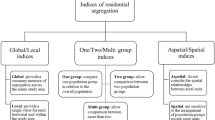Abstract
In the analysis of regionalized data, irregular sampling patterns are often responsible for large deviations (fluctuations) between the theoretical and sample semi-variograms. This article proposes a new semi-variogram estimator that is unbiased irrespective of the actual multivariate distribution of the data (provided an assumption of stationarity) and has the minimal variance under a given multivariate distribution model. Such an estimator considerably reduces fluctuations in the sample semi-variogram when the data are strongly correlated and clustered in space, and proves to be robust to a misspecification of the multivariate distribution model. The traditional and proposed semi-variogram estimators are compared through an application to a pollution dataset.






Similar content being viewed by others
References
Armstrong M (1984) Common problems seen in variograms. Math Geol 16(3):305–313. DOI 10.1007/BF01032694
Armstrong M, Delfiner P (1980) Towards a more robust variogram: a case study on coal. Technical report N-671, Ecole Nationale Supérieure des Mines de Paris, Fontainebleau
Chilès JP, Delfiner P (1999) Geostatistics: modeling spatial uncertainty. Wiley, New York, p 695
Cressie NAC (1993) Statistics for spatial data (rev. ed.). Wiley, New York, p 900
Cressie N, Glonek G (1984) Median based covariogram estimators reduce bias. Statist Probab Lett 2(5):299–304. DOI 10.1016/0167-7152(84)90069-5
Cressie N, Hawkins DM (1980) Robust estimation of the variogram. Math Geol 12(2):115–125. DOI 10.1007/BF01035243
Dowd PA (1984) The variogram and kriging: robust and resistant estimators. In: Verly G, David M, Journel AG, Maréchal A (eds) Geostatistics for natural resources characterization. Reidel, Dordrecht, pp 91–106
Emery X (2005a) Variograms of order ω: a tool to validate a bivariate distribution model. Math Geol 37(2):163–181. DOI 10.1007/s11004-005-1307-4
Emery X (2005b) Conditional simulation of random fields with bivariate gamma isofactorial distributions. Math Geol 37(4):419–445. DOI 10.1007/s11004-005-5956-0
Emery X (2006) A disjunctive kriging program for assessing point-support conditional distributions. Comput Geosci 32(7):965–983. DOI 10.1016/j.cageo.2005.10.011
Emery X, Ortiz JM (2005) Histogram and variogram inference in the multigaussian model. Stoch Environ Res Risk Assess 19(1):48–58. DOI 10.007/s00477-004-0205-5
Genton MG (1998) Highly robust variogram estimation. Math Geol 30(2):213–221. DOI 10.1023/A:1021728614555
Greenbaum A (1997) Iterative methods for solving linear systems. Society for Industrial and Applied Mathematics, Philadelphia, p 220
Isaaks EH (1984) Risk qualified mappings for hazardous waste sites: a case study in distribution free geostatistics. unpublished Master’s Thesis, Stanford University, Department of Applied Earth Sciences, p 85
Isaaks EH, Srivastava RM (1988) Spatial continuity measures for probabilistic and deterministic geostatistics. Math Geol 20(4):313–341. DOI 10.1007/BF00892982
Isaaks EH, Srivastava RM (1989) An introduction to applied geostatistics. Oxford University Press, New York, p 561
Isserlis L (1918) On a formula for the product-moment coefficient of any order of a normal frequency distribution in any number of variables. Biometrika 12:134–139
Journel AG, Huijbregts CJ (1978) Mining geostatistics. Academic, London, p 600
Kovitz JL, Christakos G (2004) Spatial statistics of clustered data. Stoch Environ Res Risk Assess 18(3):147–166. DOI 10.1007/s00477-003-0133-9
Matheron G (1971) The theory of regionalized variables and its applications. Les cahiers du Centre de Morphologie Mathématique de Fontainebleau, Fascicule 5, Ecole Nationale Supérieure des Mines de Paris, Fontainebleau, p 211
Matheron G (1989) Estimating and choosing: an essay on probability in practice. Springer, Berlin Heidelberg New York, p 141
Omre H (1984) The variogram and its estimation. In: Verly G, David M, Journel AG, Maréchal A (eds) Geostatistics for natural resources characterization. Reidel, Dordrecht, pp 107–125
Richmond A (2002) Two-point declustering for weighting data pairs in experimental variogram calculation. Comput Geosci 28(2):231–241. DOI 10.1016/S0098-3004(01)00070-X
Rivoirard J (1987) Computing variograms on uranium data. In: Matheron G, Armstrong M (eds) Geostatistical case studies. Reidel, Dordrecht, pp 1–22
Rivoirard J (2001) Weighted variograms. In: Kleingeld WJ, Krige DG (eds) Proceedings of the 6th international geostatistics congress. Geostatistical Association of Southern Africa, Cape Town, pp 145–155
Rivoirard J, Simmonds J, Foote KG, Fernandes P, Bez N (2000) Geostatistics for estimating fish abundance. Blackwell, Oxford, p 206
Srivastava RM, Parker HM (1989) Robust measures of spatial continuity. In: Armstrong M (ed) Geostatistics. Kluwer, Dordrecht, pp 295–308
Triantafyllopoulos K (2003) On the central moments of the multidimensional Gaussian distribution. Math Sci 28(2):125–128
Acknowledgment
The author acknowledges the sponsoring by Codelco-Chile for supporting this research.
Author information
Authors and Affiliations
Corresponding author
Rights and permissions
About this article
Cite this article
Emery, X. Reducing fluctuations in the sample variogram. Stoch Environ Res Risk Assess 21, 391–403 (2007). https://doi.org/10.1007/s00477-006-0072-3
Published:
Issue Date:
DOI: https://doi.org/10.1007/s00477-006-0072-3




